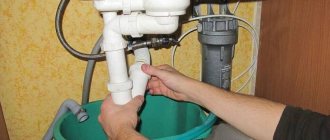The presence of running water in the house for us means not just comfort, but a necessary condition for our existence. Lack of water in the tap is a small disaster. But what to do if the water trickles out drop by drop or stops dripping completely, but there is water in the main?
We welcome our reader and bring to his attention an article on how to clean a water pipe at home.
Causes of clogging
Most often, steel pipelines become clogged. The inner surface of steel pipes is rougher, and plaque settles on it. In addition, steel is prone to corrosion - peeled rust plates also clog pipes. This is especially true for the heating system. The second reason for clogging can be the poor quality of water in the main water supply - it may contain sand, scale, slag, poorly soluble salts, and in some cases even biological contaminants.
The roughness of plastic pipes is approximately 20 times lower than steel pipes, so they can become clogged only when very contaminated water enters (for example, after accidents on main pipelines).
What and how to clean water pipes
They also accumulate inside metal pipes due to the roughness of their internal surfaces. All this leads to a decrease in water pressure in taps and the need for intervention in the water supply system. Therefore, in this article we will determine how to clean a water pipe made of various materials.
Places where the water supply is likely to be clogged
There are places in the water supply system that are most susceptible to clogging:
It is recommended to replace mixers and taps every 5-6 years.
- mesh filters located on faucets. They get clogged with small hard particles. Cleaning is done after unscrewing the nut on the mixer spout,
- water meters. The mesh filters become clogged and salts are partially deposited on the walls of the metal adapters. The problem can be solved by cleaning the filter or partially disassembling the meter. You just need to be sure that the meter is the cause of the blockage,
- bends in the pipeline, especially if they go at an angle of 90 degrees. Due to the weakening of water pressure in places of bends, a narrowing of the gaps inside the pipes is observed. This is a disease of steel structures.
Next, let's see what is the best way to clean water supply pipes if the water pressure has weakened, and manipulations with faucets and strainers have led nowhere.
Cleaning a water pipe using a cable
There are special plumbing cables made of elastic steel. With their help, you can radically solve the problem of blockages in metal pipes clogged with scale. The cable has a handle, which you can rotate to clean inside the line. At the same time, the bends can be easily passed by the cable due to its design.
- the water in the pipeline is blocked,
- taps or mixers are unscrewed,
- a cable is inserted into the clogged pipe,
- By rotating the handle, the cable is advanced along the line. In the process of movement, the cable destroys deposits on the internal walls of the water pipeline,
- Periodically it is necessary to turn on full water pressure, which will wash away all the dirt from the pipes.
It should be noted that this cleaning method is unacceptable for plastic pipes in which deposits do not form.
Cleaning the water supply with dismantling the pipe
If cleaning with a cable does not give anything, then there is a more labor-intensive way to restore normal water flow. To do this, you need to partially dismantle the pipes and clean the clogged areas.
Of course, radically solving the problem in this way is very problematic. Moreover, other sections of the pipes may subsequently become clogged. So it is better to replace them with new products.
How to clean pipes in the bathroom or kitchen? The metal sections are connected by hollow corners with threads. Therefore, disassembly is carried out by unscrewing straight sections of pipes from such corners using two gas wrenches. Disconnected pipes are cleaned with strong pressure of hot water or by mechanical cleaning with a cable. After cleaning, the system elements are connected in the reverse order.
Chemical cleaning of water pipes
How to clean water pipes with chemicals? The product is simply poured into the water supply system. After a certain time, the system is flushed with a large amount of running water. The properties of the reagents that are used as chemical cleaning agents are such that they dissolve only deposits formed on the pipe walls. They do not affect metal, polypropylene, galvanized or metal-plastic.
Chemical cleaning is especially effective in private homes, since in high-rise buildings it is very difficult to circulate the reagent through the system.
How to clean plastic drain pipes?
The question of how to clean plastic pipes is the most pressing, because now plastic plumbing is very popular. Plastic pipes have a smooth inner surface that is not subject to corrosion. Therefore, such products rarely become clogged. If deposits occur, they occur exclusively in the drainage system. Typically, fatty deposits and hair accumulate on the walls of pipes. They gradually clog the wastewater passage, which forces them to be removed.
Chemical or mechanical means can be used to clean drain pipes. Usually it is possible to do without disassembling the entire drain system. As mentioned, a plumbing cable works well. Excellent results are obtained by using chemicals that are simply poured into the sink or bathtub. After a certain time, the system is flushed with water.
Cleaning methods
Cleaning methods should be selected depending on the location of the blockage, the length of the pipelines, the method of installation (welding or threading), and the ability to disconnect the pipeline from the main.
Before starting work, the condition of the pipelines should be assessed - it is better not to touch the old ones or use chemical cleaning methods.
Tapping with an ordinary hammer
The most affordable way to clean pipes from deposits is to tap the pipes with a regular hammer.
The pipe is not disassembled, gently and lightly tapped with a hammer, then the water is turned on - it will wash away the detached plates of rust or calcium deposits. It is worth tapping the system in parts - a separate section going to the bathroom, kitchen, toilet. Tap one area - rinse with water, then the next one - and rinse again. Otherwise, you risk clogging the system completely.
The great advantage of this method is that there is no need to disassemble the pipes.
Tapping can be performed not only by a home craftsman, but also by a home craftswoman.
Plumbing cable
One of the most effective methods of removing blockages is using a small diameter plumbing cable. To do this, you should block the access of water to the area being cleaned, dismantle the tap, mixer, or any threaded fitting. Then the cable is inserted into the opened hole and moves with rotation and is removed. Then the water is opened, the blockage is washed out, then the removed fittings are mounted back.
It should be borne in mind that the cable for heating and water supply systems should not be used for sewage systems; it should not be too “tattered” - it may simply not fit into the pipeline. It is better to use a ready-made cable with a metal ring at the end. You cannot use a cable to clean the metering unit (meter).
Pipe dismantling
If all of the above cleaning methods do not help, they resort to the most extreme option - dismantling the pipes. This is possible if the pipes are assembled on threaded fittings.
First the water is turned off. Then the parts of the pipeline are unscrewed, water is supplied under pressure using a hose and washed.
You can combine cleaning with a cable or chemical methods with washing with water under pressure...
The holes on the connection hoses for the toilet tank, faucet, and water heating tank often become overgrown. You can unscrew the hoses, carefully clean the “overgrown” hole (using a screwdriver or a narrow chisel), rinse it and screw it back on.
Household chemicals
This method also involves disconnecting the system from the network. Mixers are usually located above the connection point, and chemicals must be poured from their side.
Chemical cleaning technology:
- shut off the water supply;
- dismantle the metering unit, while taking care of the safety of the seals;
- drain water;
- dismantle taps and mixers;
- plug the lowest points of the system using plugs;
- wear rubber gloves and safety glasses;
- carefully (you can use a watering can) pour in the product used; stand for 30 minutes - one hour;
- place a plastic basin under the lower part of the system;
- unscrew the plugs and drain the liquid;
- flush the system from the highest points;
- put everything back together;
- Flush the system well with water.
The ideal chemical for dry cleaning is concentrated hydrochloric acid. Formic and acetic acids can also be used, but they are much weaker, effective against plaque and ineffective against rust.
You can also use concentrated sodium hydroxide (contained in the Mole product).
Plunger and its analogues
The plunger itself is not suitable for cleaning water supply networks - it is designed for the sewer system.
Professional pneumatic guns can be considered an analogue of a plunger for small-diameter pipes. Their advantage is that they can use a jet of water to clear the blockage at a distance of several tens of meters (sometimes up to 50). But they are rarely found even in the arsenal of a professional plumber and are also expensive. At home, it is worth using other cleaning methods.
Which way is better
The best way is radical. Replace with metal-plastic. Non-galvanized steel will last you 10-15 years; galvanization - 20 years. And metal-plastic on the heating system will last at least 25 years; on water supply systems – about 50 years. And no rust!
If it is not possible to change the pipes in the near future, you can try cleaning them. The best methods are disassembly; using a cable and a pneumatic gun. Then comes the chemical one. Then tapping. This is where you should start - all other methods require skills and time. In any case, steel will have to be replaced with metal-plastic.
Frequently clogged areas
In most cases, blockages appear in sections of the pipeline that have defects or obstructions.
The most frequently clogged places.
The most frequently clogged places:
- Water filters. Nowadays, many home and apartment owners install filters that purify water from their tap water. Sometimes the reason for weakening pressure or lack of water supply is precisely the clogging of these devices.
- Filters installed on the water supply meter.
- Valves. Salt deposits that form on a faucet that shuts off the water supply can cause low water pressure or no water pressure at all.
- Faucets. Particles of salts that are present in low-quality tap water constantly break off on these elements. In addition, faucets become covered with rust over time, through which water cannot seep through.
- Pipe bends and branches. In areas where pipes bend at right angles, particles of lime and salt settle more intensively than on smooth elements. Adapters, couplings, angles and other elements become dirty with the same frequency as filters and valves.
You can clean pipes at home only if the problem did not arise due to complete wear and tear of the pipeline. Otherwise, you will have to turn to the services of specialists.
Expert advice
Do not use sulfuric acid (such as battery fluid) to clean pipes - it is unsafe to use and produces toxic compounds that can leach into drinking and shower water.
A favorite remedy for home plumbers, vinegar and baking soda are not effective for cleaning pipes.
Before cleaning, you should try to determine whether the entire system is clogged or whether only part of it is clogged - that should be cleaned.
Water meters can only be cleaned by flushing. You cannot clean it with a cable or chemically - you can damage the meter.
If there is a lot of plaque and it cannot be cleaned, it means that the meter is already 12-15 years old and you should think about replacing it.
After disassembling and reassembling part of the network, it is necessary to carry out hydraulic tests - fill the network with water and carefully check all joints for leaks.
Prevent clogging of water supply pipes - what needs to be done?
The most important protection is the primary filter. But as a rule, it is simply called a coarse filter. Structurally, it is made in the form of a regular mesh, which catches large pieces of rust. There may be several such devices in the water supply system.
In apartments of modern high-rise buildings, the filter is placed in front of the meter, and its location is a special flange along with a plug, by unscrewing which you can remove the cylindrical mesh from the channel. Don't be surprised if this mesh is so clogged with deposits that you need a nail or a screwdriver to clean the part.
Important! This mesh is specially made of stainless steel. That is why it itself is not capable of corrosion. But the rust keeps growing on it quite densely, while clogging the hole.
In addition to installing a filter, you can take the following preventive measures:
Preventing blockages
There is virtually no real prevention of blockages. It is necessary to periodically clean the inlet strainers and the mixer filter from debris and scale, and rinse or clean the pipes. Removing debris has a surprisingly good effect on the pressure in the system. Metal pipelines still become overgrown with calcium deposits and rust.
If plastic pipes are regularly clogged, it means that there are a lot of mechanical impurities in the water - this is a sign of an emergency condition of the main networks. If such problems arise, you should contact the water utility (and possibly higher authorities).
When to call a specialist
If you have never dealt with pipes, faucets, or household appliances, then call a plumber right away. You will have to contact a specialist if you were unable to clear the communications on your own. Perhaps your pipes are so clogged with deposits that they can only be replaced.
We recommend that you read: How to properly install corrugation on a toilet?
By replacing steel water pipes once with new ones, you will save yourself from problems with water supply to your apartment for decades.
Effective cleaning methods
The blockage requires prompt removal. Cleaning water pipes from the inside at home is usually not difficult. Cold and hot water lines need to be flushed periodically. Most often, plaque appears in the following areas:
- Filters - meshes for catching large particles are installed at the entrance to the apartment, in front of meters and mixers. Depending on the quality of the liquid, they clog at different rates. The filters are easy to clean by simply rinsing them with water. Complex deposits and rust are removed with an acid solution.
- Bent sections of pipes where foreign matter settles.
- Taps and mixers - layers appear on the internal parts of the structure.
- Joints – rust particles or sand cling to rough surfaces.
Lime deposits on the elements of the hot water supply system lead to a drop in the temperature of the coolant. Energy consumption for heating increases. Lime deposits are extremely hard and difficult to remove. Hot water pipes are cleaned using chemicals and mechanical devices. He considers the most effective effects on plaque to be ultrasound and electromagnetic waves.
Cleaning methods vary in speed and effectiveness. They are selected based on the degree and nature of the blockage.
Mechanical
Build-ups and blockages inside pipes are removed using mechanical devices. One of them is a plumbing cable. The device is made of metal wire and has a handle for rotation. It is used to clean water pipes from stones, sand, and lime deposits. The device nozzle is selected according to the diameter of the line. Before starting work, turn off the water. Access to the inside of the pipeline is carried out through a removed tap. The cable is advanced with rotational movements. The removed layers are washed after opening the valves. You can make the device yourself. You will need flexible, strong wire. A loop is constructed at one end, and a handle for rotation at the other.
An easy way to remove rust from water pipes is to tap them with a hammer. Before tapping, open the tap completely. The oxide will leave the system with the flow of water. Impacts must be careful not to damage the metal.
An effective method is hydraulic flushing. This is a labor-intensive process that requires dismantling the clogged area. The pipe is cleaned with a stream of water supplied under pressure. In an apartment, it will be difficult to carry out the procedure on your own.
Chemical
Hard lime deposits from hard water are dissolved with acid. Acetic or citric acid is used in everyday life. Sediment on water pipes is removed with special cleaning products. They are sold in hardware stores. The drug is poured into the system, blocking access to household appliances. The solution is left for 1-2 hours, according to the instructions for use. Then the pipeline is washed with water by opening the taps. To protect yourself from chemical residues, you need to drain the water for 30-40 minutes. The method is costly and risky. When choosing chemical reagents, the material of the pipes is taken into account. Strong acid (hydrochloric acid, phosphoric acid) can corrode plastic. When working with chemicals, it is important to follow safety precautions.
Ultrasound
Ultrasonic waves have a destructive effect on any deposits. They remove scale more effectively than chemical reagents. Under the influence of devices, re-deposition of calcium salts is prevented. Ultrasound causes structural changes in chemical compounds in a liquid.
If apartment residents do not rely on their own strength to carry out plumbing work, it is better for them to contact a special service. There are companies in every city that clean water pipes and sewer lines.
Preventive measures
Without regular maintenance, the pipeline wears out quickly. Lime deposits not only reduce water pressure, but also negatively affect the metal. Under a layer of plaque, it rusts faster and leaks appear. Preventive measures include installing a coarse filter. It is placed at the entrance, before the counter.
The part is a cylinder made of fine mesh. Filter material – stainless steel. The mesh traps large debris and rust particles. It screws into the cork flange. If the water quality is low, the cylinder quickly clogs. Regular cleaning of the filter is required, otherwise the pressure will decrease. To prevent the formation of limescale, it is recommended to use softener filters.











